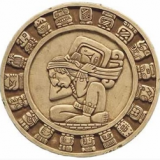DaVinci Tarot Kit: Modern Day Masterpieces for the Mind and the Soul
The “Da Vinci Tarot Kit,” is a work of art on many levels. Mark McElroy, the author of several Tarot related books and the creator of the brainstorming “Bright Idea Deck” of cards, has written the “Da Vinci Tarot” companion guide for such a kit. The book is to be used with the accompanying Da Vinci Tarot deck that’s comprised of the Major Arcana cards that were created in 1992 by Bulgarian artist Iassen Ghiuselev and the Minor Arcana cards that were completed in 2002 by fellow Bulgarian, A. Atanas Atanassov. Each component of this kit flows together into a package that is both educational and inspirational and that can be used for such purposes as meditation and divination.
Unless you’ve been living under a rock for the last several years, the release of the Da Vinci Tarot Kit should come as no surprise. Facts about the history of Leonardo Da Vinci has continued to grow since the 2003 release of Dan Brown’s “The Da Vinci Code,” a book that continues to remain near the top of many Best Sellers’ lists. With the upcoming May, 2006 release of “The DaVinci Code” movie, it’s likely that the fascination with this well-known Renaissance artist, engineer, inventor, and mathematician will likely remain strong.
Why though would someone create a tarot deck based on the work and history of Leonardo Da Vinci you wonder? One might think that it was a natural extension of his reported, but unverified, connections to “forbidden sects and secret societies” such as a cult that was committed to pagan goddess worship. However, it was really more about the ability of his artwork to “reveal their most intimate nature, that of the Arcana of the intellect and the spirit,” as well as the potential hidden messages of his paintings. It’s also interesting to ponder Da Vinci’s potential introduction to such cards during his years of employment with Ludovico Sforza, the Duke of Milan, whose family has some of the earliest ties to “triumphs” — one of the oldest references to Tarot decks — and for whom the Visconti-Sforza tarot deck is named.
The deck itself isn’t so much about “the Tarot Da Vinci would have invented,” but more about how “selected elements from [his] work [are aligned] with the archetypes, themes, and divinatory meanings associated with modern Tarot.” As Da Vinci was notorious for beginning many more projects than he ever completed, most of the Minor Arcana cards (and a few of the Major ones) feature “fleshed out” images that were taken from his numerous sketchbooks — images that were never fully brought to life during his own lifetime. The subtle, sepia tones of these stoic characters are a large departure from the more colorful, expressive cards that I usually prefer. They are however still very pleasing to the eye, as are so many of Da Vinci’s original works.
All of the cards feature titles written in English, Italian, Spanish, French, German, and Dutch. The Major Arcana cards are distinctive due to a mirror-script signature of the Italian title of the card having been incorporated into the background of the scene (a commonality found in many of Da Vinci’s sketchbooks and journals), along with a tiny glyph or pencil-like drawing that’s been “adapted from the Master’s sketches and designs [and] that hinted at the divinatory meanings and themes associated with the card.”
For each of the seventy-eight cards in the deck, the companion guide contains a descriptive list of what “actions, attitudes, and approaches” the card encourages, as well as what it cautions against. To assist the user in understanding how the card might apply to their specific situation, several “exploratory questions” are also given for each card. Along with a commentary that explains the meaning of the card, there are “illustration notes” that describe why the specific Da Vinci image was used and what it represents.
As is common for many Tarot decks and their accompanying Little White Book (LWB), McElroy’s guide also presents information that provides the user with a historical perspective pertaining to Tarot, as well as suggestions about such things as caring for the cards and preparing for a reading. There’s also a discussion about the use of Tarot cards for such wide-ranging purposes as a game of tarocchi to therapeutic tools for healing personal wounds. Two spreads specific to this deck are also presented — the Pentacle Spread that’s inspired by Da Vinci’s “Vitruvian Man,” the main character found on the Ace of Swords, and the linear, five-card Da Vinci Insight and Inspiration Spread that focuses on a specific problem or challenge of the user’s choosing.
You don’t need to be a collector of facts about Leonardo Da Vinci, an art lover, a movie buff, an avid book reader, or an experienced tarot reader to appreciate the McElroy-Ghiuselev-Atanassov DaVinci Tarot Kit. Nor do you need to wait for the upcoming release of the DaVinci Code movie to get your hands on this unique kit. Buy it now and gain valuable insight into what all of the fuss is about. It will truly lead you on many paths of exploration, as well as provide you with newfound appreciation for many aspects of life, from art to the art of living.








